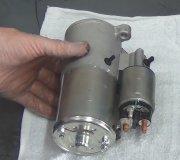If you have the phenolic, (plastic) pistons, it is normal and common for them to chip and have chunks break off. That doesn't mean they're defective.
There are a number of things to watch for when replacing pads. First of all, run a flat file over the pistons and the caliper fingers that contact the outer pads. You don't have to shine them up. You're just removing any dirt or rust buildup so the pads will sit squarely against those parts.
Use a layer of high-temperature brake grease on the backing plates of the pads and the caliper mounts so all of those things can move freely.
To prevent a crunching noise when cornering, place some grease between the rotors and the hubs where they mount. Use the flat file to remove a little of the leading edge of the pads. Bevel the corners to a 45 degree angle. That will remove the "fingernail on the blackboard" effect and reduce squeal. You only have to remove 1/32" of material. It seems if you can eliminate the squeal during the break-in period, they won't squeal later either.
Measure the rotor thickness and compare it to the published specs. If one is below the legal minimum thickness, it is possible for the piston to **** in the caliper. That won't happen with new pads but it can happen when those pads wear down. Check for excessive rust buildup on the back side of the rotors. If a lot of metal flaked off, the rotors should be replaced.
Caradiodoc
Tuesday, November 16th, 2010 AT 8:22 PM


